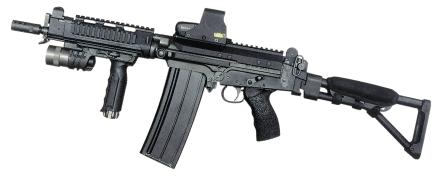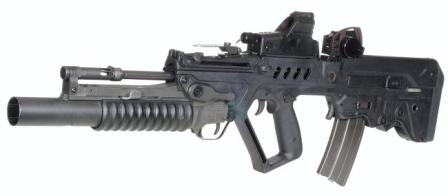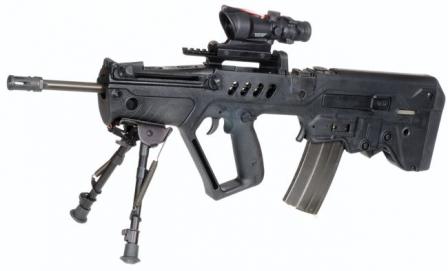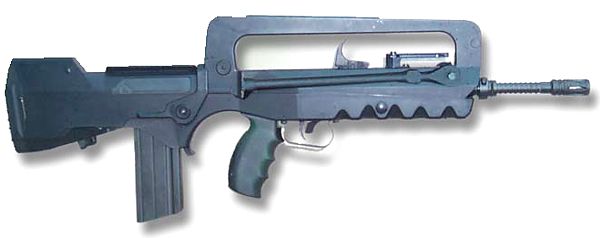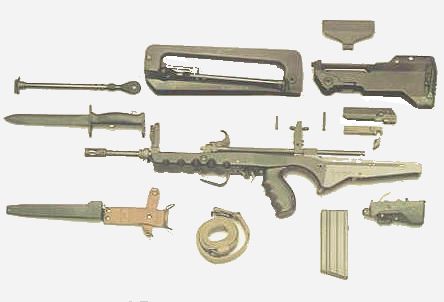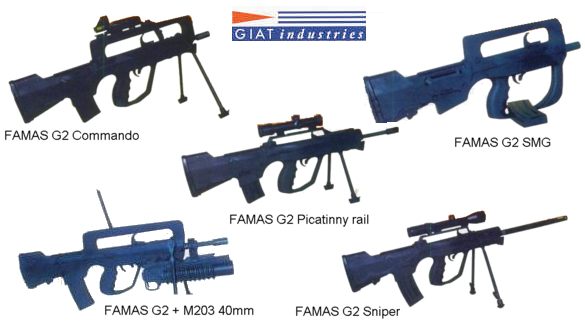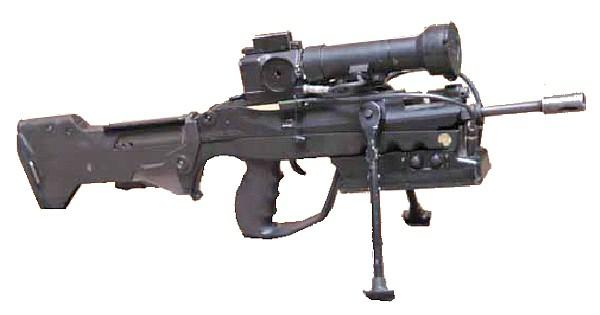FN FAL assault rifle (Belgium)
Caliber : 7,62mm NATO (7.62x51)
Action: Gas operated, tilting breechblock, select-fire or semi-auto only
Length: 1100 mm (990 / 736 mm for "Para" model)
Barrel length: 533 mm (431 mm for "Para" model)
Weight: 4.45 kg empty (3.77 kg empty for "Para" models)
Magazine capacity: 20 rounds (30 rounds for heavy barreled SAW versions)
Rate of fire: 650-700 rounds per minute
Action: Gas operated, tilting breechblock, select-fire or semi-auto only
Length: 1100 mm (990 / 736 mm for "Para" model)
Barrel length: 533 mm (431 mm for "Para" model)
Weight: 4.45 kg empty (3.77 kg empty for "Para" models)
Magazine capacity: 20 rounds (30 rounds for heavy barreled SAW versions)
Rate of fire: 650-700 rounds per minute
The FN FAL (Fusil Automatique Leger - Light Automatic Rifle) is one of the most famous and widespread military rifle designs of the XX century. Developed by the Belgian Fabrique Nationale company, it was used by some 70 or even more countries, and was manufactured in at least 10 countries. At the present time the service days of the most FAL rifles are gone, but it is still used in some parts of the world. The history of the FAL began circa 1946, when FN began to develop a new assault rifle, chambered for German 7.92x33mm Kurz intermediate cartridge. The design team was lead by Dieudonne Saive, who at the same time worked at the battle rifle, chambered for "old time" full-power rifle cartridges, which latter became the SAFN-49. It is not thus surprising that both rifles are mechanically quite similar. In the late 1940s Belgians joined the Britain and selected a British .280 (7x43mm) intermediate cartridge for further development. In 1950 both Belgian FAL prototype and British EM-2 bullpup assault rifles were tested by US Army. The FAL prototype greatly impressed the Americans, but the idea of the intermediate cartridge was at that moment incomprehensible for them, and USA insisted on adoption of their full-power T65 cartridge as a NATO standard in 1953-1954. Preparing for this adoption, FN redesigned their rifle for the newest T65 / 7.62x51mm NATO ammunition, and first 7.62mm FALs were ready in 1953. Belgium was not the the first country to adopt their own rifle in 1956. Probably the first one was a Canada, adopting their slightly modified version of FAL as C1 in 1955. Canadians set to produce C1 and heavy barreled C2 squad automatic rifles at their own Canadian Arsenal factory. Britain followed the suit and adopted the FAL in 1957 as an L1A1 SLR (Self-loading rifle), often issued with 4X SUIT optical scopes. Britain also produced their own rifles at the RSAF Enfield and BSA factories. Austria adopted the FAL in 1958 as a Stg.58 and manufactured their rifles at Steyr arms factory. Various versions of FAL were also adopted by the Brazil, Turkey, Australia, Israel, South Africa, West Germany and many other countries. The success of the FAL could be even greater if Belgians would sell the license to W.Germany, which really liked to produce the FAL as a G1 rifle, but Belgians rejected the request. Germany purchased the license for Spanish CETME rifle and as a result of this H&K G3 rifle became probably the most notable rival to FAL.
During the time, FAL was built in numerous versions, with different furniture, sights, barrel lengths etc. There are, however, four basic configurations of FAL rifle: FAL 50.00, or simply FAL, with fixed buttstock and standard barrel; FAL 50.63 or FAL "Para", with folding skeleton butt and short barrel; FAL 50.64 with folding skeleton butt of "Para" model and standard length barrel; and the FAL 50.41, also known as FAL Hbar or FALO - a heavy barreled model which was intended primary as a light support weapon. There are also two major patterns of FALs around the globe: "metric" and "inch" FALs. As the names implied, these were built in countries with metric or imperial (inch) measure systems. These patterns are slightly different in some dimensions, and magazines of metric and inch pattern sometimes could not be interchanged. Most "inch" pattern FALs were made in British Commonwealth countries (UK, Canada, Australia) and have had folding cocking handles and were mostly limited to semi-automatic fire only (except for Hbar versions like C2). Most "metric" pattern rifles had non-folding cocking handles and may or may not have select-fire capability, but as with other light select-fire weapons chambered for 7.62x51mm NATO round, the controllability of the full auto fire is disappointing and shots spread in burst is extremely wide. But, regardless of this, the FAL is one of the best so known "battle rifles", reliable, comfortable and accurate. It is somewhat sensitive to fine sand and dust but otherwise is a great weapon.
The only countries still producing the FAL rifles until the present time are the Brazil and, most surprisingly, the USA. Brazil adopted the FAL under the name LAR and manufactured it at the IMBEL facilities. The USA produced a small amount of FALs as the T-48 at H&R factory in early 1950s for Army trials, but at the present time a number of private US Companies is manufacturing various versions of FAL rifles using either surplus parts kits or newly manufactured parts. Most of these rifles are limited to semi-auto only and are available for civilian users. Probably most notable US manufacturer of FAL modifications is the DS Arms company, which produced its rifles under the name of DSA-58.
The FN FAL is a gas operated, selective fire or semi-automatic only, magazine fed rifle. It uses short piston stroke gas system with gas piston located above the barrel and having its own return spring. After the shot is fired, the gas piston makes a quick tap to the bolt carrier and then returns back, and the rest of the reloading cycle is commenced by the inertia of bolt group. The gas system is fitted with gas regulator so it could be easily adjusted for various environment conditions, or cut off completely so rifle grenades could be safely launched from the barrel. The locking system uses bolt carrier with separate bolt that locks the barrel by tipping its rear part into the recess in the receiver floor. The receivers initially were machined from the forged steel blocks, and in 1973 FN began to manufacture investment cast receivers to decrease production costs. Many manufactures, however, stuck to the machined receivers. The trigger housing with pistol grip is hinged to the receiver behind the magazine well and could be swung down to open action for maintenance and disassembly. The recoil spring is housed in the butt of the rifle in fixed butt configurations or in the receiver cover in folding butt configurations, so the folding butt versions require a slightly different bolt carrier, receiver cover and a recoils spring. The cocking handle is located at the left side of the receiver and does not move when gun is fired. It could be folding or non-folding, depending on the country of origin. The safety - fire selector switch is located at the trigger housing, above the triggerguard. It can have two (on semi-automatic) or three (on select-fire rifles) positions. The firing mechanism is hammer fired and use single sear for both semi-automatic or full automatic fire. Barrel is equipped with long flash hider which also serves as a rifle grenade launcher. Design of flash hider may differs slightly from country to country. The furniture of the FAL also can differ - it could be made from wood, plastic of various colors or metal (folding buttstocks, metallic handguards on some models). Some models, such as Austrian Stg.58 or Brazilian LAR were fitted with light bipods as a standard. Almost all heavy barrel versions also were fitted with bipods of various design. Sights usually are of hooded post front and adjustable diopter rear types, but can differ in details and markings. Almost all FAL rifles are equipped with sling swivels and most of rifles are fitted with bayonet lugs.http://world.guns.ru/assault/be/fn-fal-e.html
During the time, FAL was built in numerous versions, with different furniture, sights, barrel lengths etc. There are, however, four basic configurations of FAL rifle: FAL 50.00, or simply FAL, with fixed buttstock and standard barrel; FAL 50.63 or FAL "Para", with folding skeleton butt and short barrel; FAL 50.64 with folding skeleton butt of "Para" model and standard length barrel; and the FAL 50.41, also known as FAL Hbar or FALO - a heavy barreled model which was intended primary as a light support weapon. There are also two major patterns of FALs around the globe: "metric" and "inch" FALs. As the names implied, these were built in countries with metric or imperial (inch) measure systems. These patterns are slightly different in some dimensions, and magazines of metric and inch pattern sometimes could not be interchanged. Most "inch" pattern FALs were made in British Commonwealth countries (UK, Canada, Australia) and have had folding cocking handles and were mostly limited to semi-automatic fire only (except for Hbar versions like C2). Most "metric" pattern rifles had non-folding cocking handles and may or may not have select-fire capability, but as with other light select-fire weapons chambered for 7.62x51mm NATO round, the controllability of the full auto fire is disappointing and shots spread in burst is extremely wide. But, regardless of this, the FAL is one of the best so known "battle rifles", reliable, comfortable and accurate. It is somewhat sensitive to fine sand and dust but otherwise is a great weapon.
The only countries still producing the FAL rifles until the present time are the Brazil and, most surprisingly, the USA. Brazil adopted the FAL under the name LAR and manufactured it at the IMBEL facilities. The USA produced a small amount of FALs as the T-48 at H&R factory in early 1950s for Army trials, but at the present time a number of private US Companies is manufacturing various versions of FAL rifles using either surplus parts kits or newly manufactured parts. Most of these rifles are limited to semi-auto only and are available for civilian users. Probably most notable US manufacturer of FAL modifications is the DS Arms company, which produced its rifles under the name of DSA-58.
The FN FAL is a gas operated, selective fire or semi-automatic only, magazine fed rifle. It uses short piston stroke gas system with gas piston located above the barrel and having its own return spring. After the shot is fired, the gas piston makes a quick tap to the bolt carrier and then returns back, and the rest of the reloading cycle is commenced by the inertia of bolt group. The gas system is fitted with gas regulator so it could be easily adjusted for various environment conditions, or cut off completely so rifle grenades could be safely launched from the barrel. The locking system uses bolt carrier with separate bolt that locks the barrel by tipping its rear part into the recess in the receiver floor. The receivers initially were machined from the forged steel blocks, and in 1973 FN began to manufacture investment cast receivers to decrease production costs. Many manufactures, however, stuck to the machined receivers. The trigger housing with pistol grip is hinged to the receiver behind the magazine well and could be swung down to open action for maintenance and disassembly. The recoil spring is housed in the butt of the rifle in fixed butt configurations or in the receiver cover in folding butt configurations, so the folding butt versions require a slightly different bolt carrier, receiver cover and a recoils spring. The cocking handle is located at the left side of the receiver and does not move when gun is fired. It could be folding or non-folding, depending on the country of origin. The safety - fire selector switch is located at the trigger housing, above the triggerguard. It can have two (on semi-automatic) or three (on select-fire rifles) positions. The firing mechanism is hammer fired and use single sear for both semi-automatic or full automatic fire. Barrel is equipped with long flash hider which also serves as a rifle grenade launcher. Design of flash hider may differs slightly from country to country. The furniture of the FAL also can differ - it could be made from wood, plastic of various colors or metal (folding buttstocks, metallic handguards on some models). Some models, such as Austrian Stg.58 or Brazilian LAR were fitted with light bipods as a standard. Almost all heavy barrel versions also were fitted with bipods of various design. Sights usually are of hooded post front and adjustable diopter rear types, but can differ in details and markings. Almost all FAL rifles are equipped with sling swivels and most of rifles are fitted with bayonet lugs.http://world.guns.ru/assault/be/fn-fal-e.html






